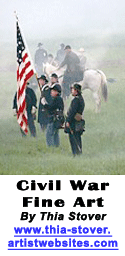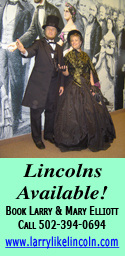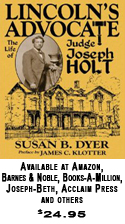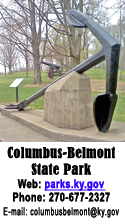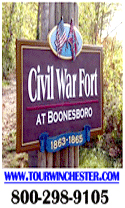|
Battle of Richmond mural capsulizes
conflict, aftermath of two-day affair
Murals tell a story, and that’s what a mural by the late Richard Deane does for the Civil War Battle of Richmond.
A 6x8-foot oil-on-canvas painting was commissioned in 2006 by the Richmond Kiwanis Club, a rendering designed to depict the aftermath of fighting on Aug. 30, 1862, as wounded soldiers were transported to and treated at the Palmer House, one of many residences used as hospitals during the two-day battle.
The Palmer House, where the mural is displayed, is now the clubhouse for Battlefield Golf Club. At the time of the battle, the house was the residence of the Thomas Palmer family and was severely damaged by a two-hour artillery bombardment.
The Richmond battlefield stretched for several miles south of the town and was too big to be included in a single mural. But Deane, a Richmond artist and former Eastern Kentucky University art professor, utilized a single scene to illustrate a wider view of the bloody conflict.
A wounded soldier being carried on a stretcher towards the house represents Gen. John Miller. Miller was a prominent descendent of Richmond’s founding family and had been a general in the Kentucky militia. At the time of the battle, he had been appointed by President Abraham Lincoln as the internal revenue commissioner for eastern Kentucky.
Miller volunteered to serve as a civilian aide-de-camp when the Confederates invaded Kentucky, but ended up in the thick of the fight. He was wounded in action and died six days after the battle.
Barefoot Confederate soldiers depicted in the painting are realistic as many Confederates wore out their shoes as they marched and dragged artillery and wagons through the mountains to reach central Kentucky. The Confederate officer directing action in front of the Palmer House also is realistic. The Confederate army had a professional officer corps with many trained at the U.S. Military Academy at West Point, the Virginia Military Institute and The Citadel in South Carolina.
Military uniforms portrayed in the painting are authentic as is the scene of a woman leading two children toward the house, even as wounded soldiers are being carried inside. The woman is Elizabeth Armstrong, a neighbor who brought her children to the house for safety. Two servants accompany the Armstrongs, intimating that slavery was a key factor in the battle and Civil War.
The Battle of Richmond, fought Aug. 29-30, 1862, was the second largest Civil War battle in Kentucky and was one of the most decisive and complete Confederate victories of the entire war.
|


